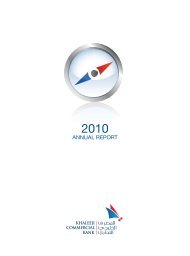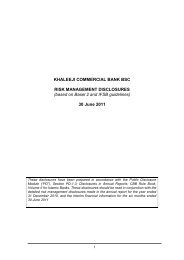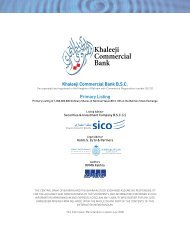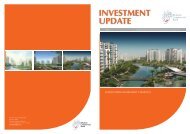2011 Annual Report - Khaleeji Commercial Bank BSC
2011 Annual Report - Khaleeji Commercial Bank BSC
2011 Annual Report - Khaleeji Commercial Bank BSC
You also want an ePaper? Increase the reach of your titles
YUMPU automatically turns print PDFs into web optimized ePapers that Google loves.
KHALEEJI COMMERCIAL BANK <strong>BSC</strong><br />
NOTES TO THE CONSOLIDATED FINANCIAL STATEMENTS<br />
for the year ended 31 December <strong>2011</strong><br />
BD 000’s<br />
31. RISK MANAGEMENT (continued)<br />
Market Risk (continued)<br />
Management of market risks<br />
The <strong>Bank</strong> separates its exposure to market risk between trading and non-trading portfolios. The <strong>Bank</strong> has no trading positions<br />
in equity or commodities and the main source of market risk for the <strong>Bank</strong> is its foreign exchange exposure and profit rate gap.<br />
The <strong>Bank</strong> does not do any trading in foreign exchange. The <strong>Bank</strong> does not engage in proprietary trading of foreign exchange<br />
derivatives. However, the <strong>Bank</strong> enters into Shari’a compliant foreign exchange risk management transactions to hedge economic<br />
risks to cover significant open positions under its risk management guidelines. All foreign exchange income / losses arising out<br />
of customer transactions and revaluation of statement of financial position assets and liabilities are booked by the treasury<br />
operations. The responsibility for monitoring and managing the related risks also rests with the Treasury department.<br />
Overall authority for market risk management is vested with ALCO. The RMD is responsible for the development of detailed<br />
risk management policies (subject to review and approval by appropriate approval authorities) and the Financial Control<br />
Department is responsible for the day-to-day review of their implementation.<br />
Exposure to profit rate risk-non-trading portfolios<br />
The principal risk to which non-trading portfolios are exposed is the risk of loss from fluctuations in the future cash flows or<br />
fair values of financial instrument because of a change in market profit rates. Profit rate risk is managed principally through<br />
monitoring profit rate gaps and by having pre-approved limits for repricing bands. The ALCO is the monitoring body for<br />
compliance with these limits and is assisted by the <strong>Bank</strong>’s Risk Management Department in its day-to-day monitoring activities.<br />
A summary of the <strong>Bank</strong>’s profit rate gap position at 31 December <strong>2011</strong> is as follows:<br />
31 December <strong>2011</strong> Up to 3 - 6 6 months 1 - 3 More than Total<br />
3 months months to 1 year years 3 years<br />
Assets<br />
Placements with financial institutions 76,787 - - - - 76,787<br />
Financing assets 26,538 6,515 4,328 72,118 92,057 201,556<br />
Assets acquired for leasing<br />
(including lease rentals receivable) 366 - - 1,745 11,547 13,658<br />
Investments securities (sukuk) 4,067 8,221 3,664 3,110 2,610 21,672<br />
Total profit rate sensitive assets 107,758 14,736 7,992 76,973 106,214 313,673<br />
Liabilities and investment accounts<br />
Placements from financial institutions 45,435 - - - - 45,435<br />
Placements from non-financial<br />
institutions and individuals 44,965 - 83 72 1,527 46,647<br />
Customers’ current accounts 286 - - - - 286<br />
Equity of investments account holders 128,269 24,601 42,467 30 - 195,367<br />
Total profit rate sensitive liabilities<br />
and investment accounts 218,955 24,601 42,550 102 1,527 287,735<br />
Profit rate gap (111,197) (9,865) (34,558) 76,871 104,687 25,938<br />
74<br />
<strong>Annual</strong> <strong>Report</strong> <strong>2011</strong>










